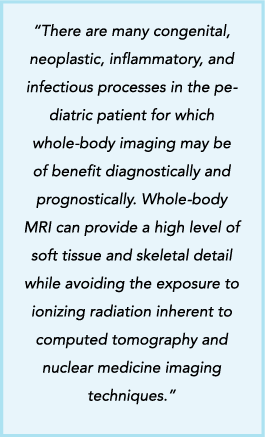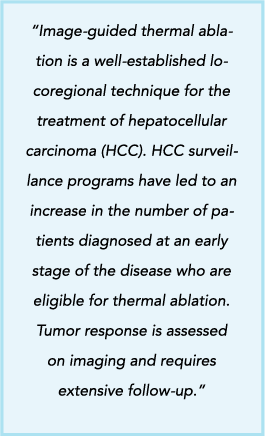| A Message from the SMRT Publications Committee about the Home Study Educational Seminars | ||||||
|
||||||
|
Vol.20 #1: Pediatric Whole-Body MRI: A Review of Current Imaging Techniques and Clinical Applications We are pleased to present the SMRT Educational Seminars, Volume 20, Number 1: “Pediatric Whole-Body MRI: A Review of Current Imaging Techniques and Clinical Applications”; and Volume 20, Number 2: “Imaging Review of Hepatocellular Carcinoma After Thermal Ablation: The Good, the Bad, and the Ugly.” These are the 77th and 78th accredited home studies developed by the SMRT, exclusively for SMRT members. The accreditation is conducted by the SMRT acting as a RCEEM (Recognized Continuing Education Evaluation Mechanism) for the ARRT. Category A credits are assigned to each home study, which can be used to maintain one’s ARRT advanced registry. SMRT Home Studies are also approved for AIR (Australian Institute of Radiography), NZIMRT (New Zealand Institute of Radiation Technology) and CPD Now (The College of Radiographers, United Kingdom) continuing professional development (CPD) activities.
The authors of the Volume 20, Number 2 home study reviewing the imaging of hepatocellular carcinoma after thermal ablation begin by saying “Image-guided thermal ablation is a well-established locoregional technique for the treatment of hepatocellular carcinoma (HCC). HCC surveillance programs have led to an increase in the number of patients diagnosed at an early stage of the disease who are eligible for thermal ablation. Tumor response is assessed on imaging and requires extensive follow-up.” This peer-reviewed, comprehensive article discusses the basic concepts including the physical principles of thermal ablation, objectives and terminology. Imaging schedules, techniques and scan protocols are described including examples of MRI and CT images. Finally, challenges such as incomplete treatments, progressive disease and complications are reviewed. A special thank you to Michael Kean, R.T., FSMRT, from Melbourne, Victoria, Australia for acting as the Expert Reviewer for Volume 20, Number 1: “Pediatric Whole-Body MRI: A Review of Current Imaging Techniques and Clinical Applications.” A special thank you to Nancy Hill Beluk, RT(R), from Pittsburgh, Pennsylvania, USA for acting as the Expert Reviewer for Volume 20, Number 2: “Imaging Review of Hepatocellular Carcinoma After Thermal Ablation: The Good, the Bad, and the Ugly.” Thanks also to Heidi Berns, M.S., R.T. (R)(MR), FSMRT, Chair of the SMRT RCEEM Ad-hoc committee from Coralville, Iowa, USA and all those who participate on this committee by reviewing the home studies for accreditation. Finally, many thanks to Kerry Crockett, Associate Executive Director, Mary Keydash, Director of Marketing, Sally Moran, Director of IT and Web, Barbara Elliott, SMRT Coordinator, John Celio, IT Coordinator, and the entire staff in the Concord, California, USA office of the ISMRM and SMRT for their insight and long hours spent supporting these educational symposia. |
||||||
| These new home studies are coming soon! When they go live, log in here and click the "SMRT E-Learning" button to access them. |
||||||
| Click to go back | ||||||
Signals is a publication produced by the International Society for Magnetic Resonance in Medicine for the benefit of the SMRT membership and those individuals and organizations that support the educational programs and professional advancement of the SMRT and its members. The newsletter is the compilation of editor, Julie Strandt-Peay, BSM, RT (R)(MR) FSMRT, the leadership of the SMRT and the staff in the ISMRM Central Office with contributions from members and invited participants.
|



 The Volume 20, Number 1 Pediatric Imaging home study is introduced by the authors who state “There are many congenital, neoplastic, inflammatory, and infectious processes in the pediatric patient for which whole-body imaging may be of benefit diagnostically and prognostically. Whole-body MRI can provide a high level of soft tissue and skeletal detail while avoiding the exposure to ionizing radiation inherent to computed tomography and nuclear medicine imaging techniques.” This peer-reviewed, previously published article includes imaging techniques, and current indications for pediatric whole-body MRI such as oncologic/neoplastic and infectious/inflammatory diseases plus image examples. Decision-making for the appropriate imaging modality is also discussed.
The Volume 20, Number 1 Pediatric Imaging home study is introduced by the authors who state “There are many congenital, neoplastic, inflammatory, and infectious processes in the pediatric patient for which whole-body imaging may be of benefit diagnostically and prognostically. Whole-body MRI can provide a high level of soft tissue and skeletal detail while avoiding the exposure to ionizing radiation inherent to computed tomography and nuclear medicine imaging techniques.” This peer-reviewed, previously published article includes imaging techniques, and current indications for pediatric whole-body MRI such as oncologic/neoplastic and infectious/inflammatory diseases plus image examples. Decision-making for the appropriate imaging modality is also discussed.